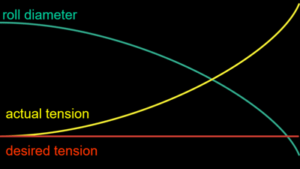
Roll-to-roll processing is a fabrication method used in manufacturing that embeds, coats, prints or laminates varying applications onto a flexible rolled substrate material as that material is fed continuously from one roller on to another. The roll-to-roll technique typically consists of several rollers, known as the web path, which winds the substrate material over and through these rollers as it carries out a number of operations. The technique applies additive or subtractive materials onto the substrate as it moves along the web to create or produce a product or part.
Roll-to-roll processing, or R2R, is also referred to as web processing or reel-to-reel processing. In any event, substrate-based manufacturing methods may vary in material, but R2R processing technology is essentially the same – roll-to-roll is the physical process that unwinds a roll of substrate material through a process for the purpose of fabrication of that material as the continuous movement rolls the substrate up into another roll.
The Roll-to-Roll Manufacturing Process
 A substrate is derived from a web made of thin, flexible, and long material. The web materials are then stored or transported as rolls for and between roll-to-roll processing stages. The materials consist of paper, foil, plastic films, textiles, metals, and even nanomaterials. R2R processing can laminate, coat, print, or embed other material on the substrate as the web material moves from reel to reel. Generally referred to as converting, once the material has been applied to the substrate it is re-reeled to produce an output roll.
A substrate is derived from a web made of thin, flexible, and long material. The web materials are then stored or transported as rolls for and between roll-to-roll processing stages. The materials consist of paper, foil, plastic films, textiles, metals, and even nanomaterials. R2R processing can laminate, coat, print, or embed other material on the substrate as the web material moves from reel to reel. Generally referred to as converting, once the material has been applied to the substrate it is re-reeled to produce an output roll.
Efficiency of Webs vs Sheets
The primary reason that manufacturers utilize webs instead of sheets of material is one of scale and, ultimately, economics. As roll-to-roll processing is continuous, production is achieved at far higher speeds. There are no start-stop issues that are associated with sheet processing. The roll-to-roll process can mass produce rolls of finished material at high production rates efficiently and cost-effectively.
Roll-to-Roll Applications & Industries
R2R processing is utilized in numerous manufacturing and industrial sectors – IT, electronics and computing, energy, textiles, medical, metal fabrication, and biosciences, to name a few. Many applications require flexible material for completing a finished product. From electronic devices, solar panels, thin-film batteries to fuel cell membranes, coating textiles with agents, and medical or scientific devices – are all produced through roll-to-roll processing. For example, in the production of large-area electronic devices, flexible displays or circuit boards is achieved through R2R processing from rolls of plastic film or metal foil.
Web Tension Control in Roll-to-Roll Systems
The effectiveness of roll-to-roll processing relies on the precision of web tension control. Tension control of the substrate web as it moves from roll-to-roll is critical to production. R2R processing must remain constant and uniform throughout the process. Any minor variation in tension could destabilize the material applied to the substrate, rendering the register or product unusable.
The Challenges of Roll-to-Roll Tension Control
 In roll-to-roll processing, the substrate properties may change as the web is loaded. Then, as the web moves downstream, tension must remain uniform and maintained consistently. That constant tension must be maintained in direct proportion to the process being performed in each tension zone. Tension zones are variables within the roll-to-roll press. So much so that once a change in tension occurs it can create a cascading effect between all zones that impacts the uniformity and stability of the entire web.
In roll-to-roll processing, the substrate properties may change as the web is loaded. Then, as the web moves downstream, tension must remain uniform and maintained consistently. That constant tension must be maintained in direct proportion to the process being performed in each tension zone. Tension zones are variables within the roll-to-roll press. So much so that once a change in tension occurs it can create a cascading effect between all zones that impacts the uniformity and stability of the entire web.
Without web tension control throughout the entire roll-to-roll processing, substrate expansion may occur leading to cracks, wrinkling, short circuiting, or de-lamination. It could also affect web velocity in such areas as the print zone, consequently affecting the resolution of fine lines.
R2R Tension Control Solutions
The answer is automated web tension control during the roll-to-roll processing. Automation of tension control will continuously measure the web for maximum production efficiency. The moving web passes over rollers fitted with load cells to accurately measure the pulling force on that roller when subjected not only to tension, but the angle of wrap around the roller. Montalvo’s exclusive Variable Wrap Angle Technology™ has improved conventional web tension control. The system eliminated the need for isolation of the tension sensing roll with a lead-in or lead-out idler roll.



